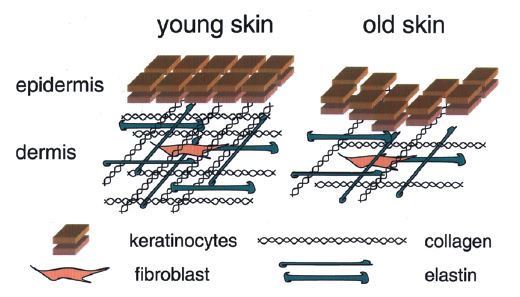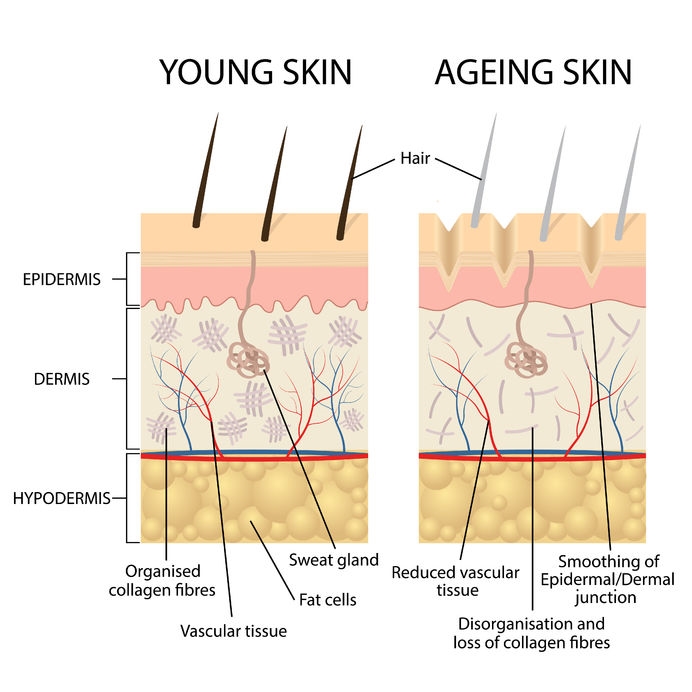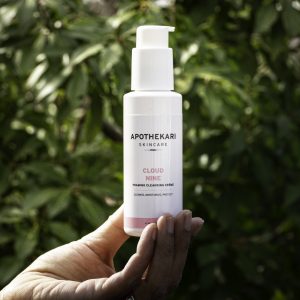Aging skin – it’s one of those unavoidable side effects of getting older. While we likely appreciate the wisdom, experience and sense of accomplishment that come with age, we may not necessarily applaud what looks back at us in the mirror.
Our skin ages in one of two ways – intrinsically or extrinsically. Intrinsic aging is the natural process that takes place over the years regardless of outside influences. Our genetic make-up, hormonal and metabolic processes account for intrinsic aging. Extrinsic aging occurs due to external factors such as sun exposure and environmental damage (pollution and smoking, for example). While we can’t necessarily control intrinsic aging, we can generally minimize the impact of extrinsic factors.
Aging Skin Symptoms
Aging skin tends to appear:
- Thinner and more transparent
- Slacker (saggier and looser)
- More fragile and more prone to damage (bruising) due to thinner blood vessel walls
- Drier
- Wrinkled
- Duller
- Rougher
- Unevenly toned. With age spots and possibly lesions.
- Different in shape
In this blog post let’s look at the ways in which skin ages so that in part 2, we can visit some specific strategies to help keep your aging skin looking its very best. 
1. Changes in the Epidermis
This outer barrier of our skin protects us from environmental insults, such as bacteria and ultraviolet (UV) radiation. Due to the natural aging process and sun exposure, changes occur. The most obvious one occurs at the epidermaldermal junction – the space between the epidermis and the dermis – where a flattening of ridges occurs. This results in less surface contact of the epidermis and dermis and leads to a reduced exchange of nutrients between these two parts. Aging skin doesn’t get as much nourishment.
2. Changes in the Dermis
The dermis sits under the epidermis and contains a very complex arrangement of proteins, including collagen and elastin, which are responsible for skin’s strength and elasticity. Fibroblasts (skin cells) start producing fewer proteins:
- Elastin, which gives our skin elasticity and rebound. The result is sag.
- Collagen, which gives our skin firmness contributing to a significant reduction in elasticity. The result is thinner more fragile skin.
- Glycosaminoglycans (GAGs), which help to keep skin hydrated. The result is more dryness. And, there are fewer Blood Vessels, resulting in less blood volume and leaving the area deficient in nutrients.
3. Changes in Fat Tissue
The subcutaneous fatty layer (also called the hypodermis) below the skin starts to shrinks, resulting in sagging. Fat is depleted and accumulates in areas including the forehead, the mouth, the eyes, the nose, the jaws and the cheeks. In young skin, fat tissue is widely distributed, but in aged skin fat tends to accumulate in pockets, which droop and sag due to the force of gravity.
4. Hormonal Slowdown
A decline in hormone production including estrogen, testosterone and dehydroepiandrosterone (DHEA) occurs. Other hormones such as melatonin, insulin, cortisol, thyroxine, and growth hormone decline too. Certain signaling molecules such as cytokines and chemokines decline as well, leading to the deterioration of several skin functions. Estrogen and progesterone are thought to contribute to skin elasticity.
5. Gravity
Over time, gravity plays a role resulting in an altered distribution of fat, which contributes to sagging. This is particularly prominent in the upper and lower eyelids, on the cheeks, and in the neck region. gravity causes drooping of the eyebrows and eyelids, looseness and fullness under the cheeks and jaw (jowls and “double chin”), and longer ear lobes.
6. Facial Bones and Cartilage
Expression lines appear as result of repeated facial muscle movement especially over the forehead and between eyebrows, and in nasolabial folds and eye areas. Repeated folding of the skin during sleeping in the same position on the side of the face contributes to appearance of “sleeping lines.” Bone mass declines and enhances the appearance of facial sagging and wrinkling.
7. Extrinsic Aging
Possibly the biggest factor in aging skin is the impact of sun and environmental damage (tobacco use and exposure to pollution, for example), diet and lifestyle factors. These contribute to skin thickening, freckles and sun spots and possibly precancerous changes such as lesions called actinic keratosis and skin cancer (including basal cell carcinoma, squamous cell carcinoma, lentigo maligna melanoma).
Over time, the sun’s ultraviolet (UV) light damages elastin, collagen and GAGs which causes the skin to sag, stretch, and lose its ability to snap back after stretching. The skin also becomes drier, bruises and tears more easily and takes longer to heal. The impact of sun damage may not show when you’re young, but it will later in life. As of yet, no one has found an answer to stopping the skin’s natural aging process.
But rest assured, science has given us a few tools to counteract its impact. Yes, aging skin is an inevitable process but by starting to take care of your skin at an early age you can help to minimize the damage. All is not lost. In part 2, let’s take a look at this.







